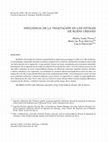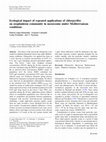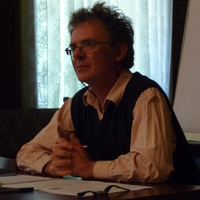Papers by Carlos Fernandez
Revista Eia, Dec 1, 2009
The objective of the study was to assess the capacity of vegetation to reduce the noise in the Ab... more The objective of the study was to assess the capacity of vegetation to reduce the noise in the Aburrá valley. The methodology comprised two phases: the first was the revision of secondary information related to the role of vegetation and to obtain the conceptual bases for further ...
Bulletin of Environmental Contamination and Toxicology, Jun 1, 2010
Screening whole effluent toxicity tests are cost/effective methods for detecting the presence of ... more Screening whole effluent toxicity tests are cost/effective methods for detecting the presence of toxic concentrations of unknown pollutants, but the application must solve the problem associated with the effect of high and variable concentrations of nutrients in the effluent on the results of algal toxicity tests. This work proposes a cost/effective test, based on three dilution levels measured at a single point time and a discriminant model for establishing if this kind of complex samples, with difficult interpretation of dilution-response curves, should be considered toxic to algae. This procedure identified properly around 85% of the samples considered toxic by expert judgement.

J Mass Spectrometry, 1993
A strategy for the structural characterization of the four major NaBH4-reduced peptidoglycan mono... more A strategy for the structural characterization of the four major NaBH4-reduced peptidoglycan monomers derived from muramidase-digested peptidoglycan from the cyanelles of the flagellate Cyanophora paradoxa Korschikoff is described. Initial molecular weight determination of these glycopeptides was performed by positive and negative ion plasma desorption mass spectrometry. Due to the presence of two pairs of disaccharide tripeptide and disaccharide tetrapeptide monomers differing in mass by 112 units, respectively, an as yet unknown peptidoglycan modification either at the carbohydrate or at the peptide moiety was assumed. beta-Elimination of the disaccharide unit from the unreduced peptidoglycan monomers yielded the corresponding (modified) N1-lactyltripeptides and -tetrapeptides, respectively. These peptides, N-terminally blocked with lactic acid, unambiguously showed the modification to be located on the peptide moiety. By positive ion fast atom bombardment/hybrid tandem mass spectrometry of the reduced peptidoglycan monomers as well as of the corresponding deglycosylated monomers (= N1-lactylpeptides) the modification was determined to be linked to the glutamic acid moiety. Based on combined data from plasma desorption mass spectrometry, tandem mass spectrometry, accurate mass measurement and amino acid analysis of the acid hydrolysate after derivatization with o-phthaldialdehyde by high-performance liquid chromatography we could establish the structure of the modification as N-acetylputrescine. Finally, the confirmation of the linkage of the glutamic acid to diaminopimelic acid via the gamma-COOH was based on the presence of a-type peptide backbone fragment ions in the positive ion plasma desorption mass spectra of the modified N1-lactylpeptides.

Revista Facultad De Ingenieria Universidad De Antioquia, 2011
ABSTRACT Brain computer interface systems use brain signals to enable the control of external dev... more ABSTRACT Brain computer interface systems use brain signals to enable the control of external devices, such as: wheelchairs, communicators, neuro-prosthesis, among others; in people with severe motor disabilities. In this study two young men with motor disabilities were trained to learn how to control a brain computer interface (BCI) using the P300 evoked potential recorded by electroencephalography (EEG). This interface enables the verbal communication through a stimulation matrix (4x3 rows and columns) that contains the picture of current football players and a sound related to each one which reproduced the name of them. Initially, we did the preparation stage that allowed the users to learn how to control the BCI. After this, the real probes were performed in two stages: the training tests and the online tests, where the participant could select the icons that he wanted through his brain signals. The average percentages of success for each participant were: 95% and 85%, respectively. The average time for an icon selection was 36 seconds (i.e.1.67 letters/minute).
Icarus, Mar 1, 2010
This work shows the results of a detailed structural analysis of the deformation belts of Lavinia... more This work shows the results of a detailed structural analysis of the deformation belts of Lavinia Planitia. Ridge belts and graben and groove belts can be observed at the studied area, while wrinkle ridges and large individual grooves predominate in the smooth plains. Transcurrent components of displacement are commonly observed, and transpression and transtension zones are the rule rather than

ABSTRACT In southern Europe and the western Mediterranean, Permo-Carboniferous magmatism is well ... more ABSTRACT In southern Europe and the western Mediterranean, Permo-Carboniferous magmatism is well represented in areas of Iberia, the Alps, Sardinia and the Balkan Peninsula. In Iberia, the magmatism that has been related to the Variscan orogeny is associated with syn-orogenic events at ca. 350-315 Ma and post-orogenic at ca. 310-295 Ma. In the southern Pyrenees there is Permo-Carboniferous sedimentary basins with a significant volume of rhyolitic ignimbrites and andesitic flows. The Erill Castell-Estac, Cadí and Castellar de n'Hug basins are spatially associated with the Boí, Montellá and Vielha granites and the Cardet dacitic dykes emplaced in Variscan basement rocks. U-Pb SHRIMP dating of zircons extracted from these granites, an andesitic flow, a dacitic dyke and six ignimbrites, revealed that magmatism was active from ca. 304 Ma to ca. 266 Ma. The scattering of zircon ages in each sample shows that the history of melt crystallization was prolonged and complex. The reported ages of the magmatic activity for the Southern Pyrenees in the range ca. 304-283 Ma (this study) fit in well with the time interval of magmatism related to the early North-dipping subduction of the Western Paleotethys Ocean, the subsequent development of Iberian orocline (Variscan cycle), and the large-scale bending and blocking of the Paleotethys Ocean subduction at East of Iberia. In paleogeographic reconstructions of the Permo-Carboniferous, Iberia is located in the core of Pangaea to the east of the probable Rheic Ocean suture and near the western end of the subduction zone of the Paleotethys Ocean. The emplacement in Iberia of granites with ca. 310-278 Ma age occurred after the collision of Laurussia and Gondwana, when the subduction of the Rheic Ocean was inactive. From a Variscan-cycle perspective, the Permo-Carboniferous magmatism of the Pyrenees has been considered as post-orogenic. However, global paleogeographic reconstructions put Iberia in between the Rheic Ocean suture and the still active subduction zone of the Western Paleotethys Ocean. Therefore, the Permo-Carboniferous magmatism of Iberia, from a Cimmerian-cycle perspective, may have accompanied the closing of the Paleotethys Ocean. During this stage of the evolution of Pangaea, the east of Iberia was geologically affected by the active subduction zone of the Paleotethys Ocean. The period ca. 310-285 Ma is marked by the development of an orocline that extends from Iberia to Armorica. The northwards subduction of the western corner of Paleotethys probably caused orocline formation and consequent large-scale bending and blocking of Paleotethys subduction immediately east of Iberia. The Permo-Carboniferous magmatism of Iberia, coeval with this tectonic evolution, shows a mixed imprint of subduction and delamination geochemical signatures. Although this may seem controversial, in our view the magmatic activity preserved in the Southern Pyrenees could provide the missing link between the development of the Iberian orocline and the continued subduction of easternmost segments of the Paleotethys Ocean (Cimmerian cycle) during the evolution of Pangaea.
Current Science, 2006
Experimental petrology is a valuable tool to test different models proposed to account for the or... more Experimental petrology is a valuable tool to test different models proposed to account for the origin of Archaean granitoids. However, a feasible petrogenetic model needs to be supported by studies from different disciplines. Therefore, the present article is a synthesis of experimental studies on the origin of Archaean granitoids (TTG and K-rich granites). Besides, a review of the published work about their origin is briefly discussed. Finally, the experimental synthesis and new results, along with the review presented allow us to propose a model for the evolution of the early continental crust.
Journal of Structural Geology, May 1, 2010
Use of stress inversion methods on faults measured at 33 sites located at the northwestern part o... more Use of stress inversion methods on faults measured at 33 sites located at the northwestern part of the South Portuguese Zone (Variscan Iberian Massif), and analysis of the basic dyke attitude at this same region, has revealed a prominent perturbation of the stress ...
En esta ponencia se presenta la metodología de evaluación de prácticas utilizada en algunas de la... more En esta ponencia se presenta la metodología de evaluación de prácticas utilizada en algunas de las asignaturas del área de Ingeniería de Sistemas y Automática de la Universidad Miguel Hernández. Básicamente, se propone la eliminación de los informes o memorias de los alumnos y la realización de un examen práctico de corta duración en el laboratorio y sobre los equipos de prácticas. Se muestran los resultados obtenidos en cuanto a aumento del interés de los alumnos por las prácticas.
Economia Y Sociedad, Feb 8, 2013

Revista Eia, 2009
El objetivo del estudio fue evaluar la capacidad de la vegetación para mitigar el ruido en el val... more El objetivo del estudio fue evaluar la capacidad de la vegetación para mitigar el ruido en el valle de Aburrá. La metodología comprendió dos fases: la primera consistió en la revisión de información secundaria relacionada con dicha función de la vegetación, lo que permitió obtener las bases conceptuales para el posterior desarrollo experimental. En la segunda fase se realizó la medición de los niveles de ruido a 10 m de la fuente sonora (vía de alto tráfico vehicular) en zonas verdes públicas urbanas con diferentes coberturas vegetales (arbórea, arbustiva y arbórea-arbustiva) y sin vegetación. Los resultados no arrojaron diferencias significativas entres los sitios con vegetación y sin ella, lo que permite inferir que en las condiciones del estudio, caracterizadas por contar con unos pocos individuos arbóreos o arbustivos dispersos y poco densos, la vegetación no cumple un papel significativo en la disminución del ruido. Por lo tanto, para su control en zonas urbanas deben tomarse medidas diferentes a la plantación de árboles, o establecer barreras vivas más anchas, largas, altas y densas.

Ecotoxicology, Jun 1, 2008
The effects of the insecticide chlorpyrifos were studied in plankton-dominated mesocosms under Me... more The effects of the insecticide chlorpyrifos were studied in plankton-dominated mesocosms under Mediterranean conditions. Chlorpyrifos was applied four times at 1 week intervals at nominal concentrations of 0.033, 0.1, 0.33, and 1 lg/l simulating repeated agricultural applications. The lowest 7 days time weighted averaged concentrations (TWAC) during the 28 days exposure period were calculated using the FOCUS equation to express the no observed effect concentration (NOEC) values. At population level the lowest NOEC calculated was 0.012 lg/l (treatment concentration 0.033 lg/l). The most affected taxon was Cladocera (Daphnia group galeata) followed by Copepoda (cyclopoids and nauplii). No effects were observed on phytoplankton (chlorophyll-a biomass) at any treatment level. The smallest NOEC community calculated by means of multivariate techniques was 0.1 lg/l when expressed in terms of the nominal treatment level and 0.074 lg/l when based on the lowest 7 days TWA concentration during the 28 days application period. Indirect effects on zooplankton populations were observed due to shifts in competition and predation between populations. Compared with previous micro/mesocosm experiments simulating a single application exposure regime, results from our study revealed a lower threshold level for the most sensitive measurement endpoint (difference a factor of three (in terms of nominal treatment level), more severe indirect effects and longer recovery periods of the affected populations ([13 weeks in the test systems treated with 1 lg/l). These differences could be attributed to the repeated pulse exposure scenario approach designed for our studies together with the particular climatic conditions involving our Mediterranean mesocosms (i.e., temperature, cladocerans life history, and algae blooms).
Revesco Revista De Estudios Cooperativos, 2006
Carlos GARCÍA-GUTIÉRREZ FERNÁNDEZ *











Uploads
Papers by Carlos Fernandez